Contemporary Economic Analysis: Law of Demand and Supply, Emerging Models and Theories
VerifiedAdded on 2023/06/08
|11
|3204
|453
AI Summary
This report explains the law of demand and law of supply in the context of Tesco PLC. It also discusses the factors affecting the demand and supply curve of the company. Additionally, it compares emerging models and theories in 21st and 20th century contemporary economics.
Contribute Materials
Your contribution can guide someone’s learning journey. Share your
documents today.
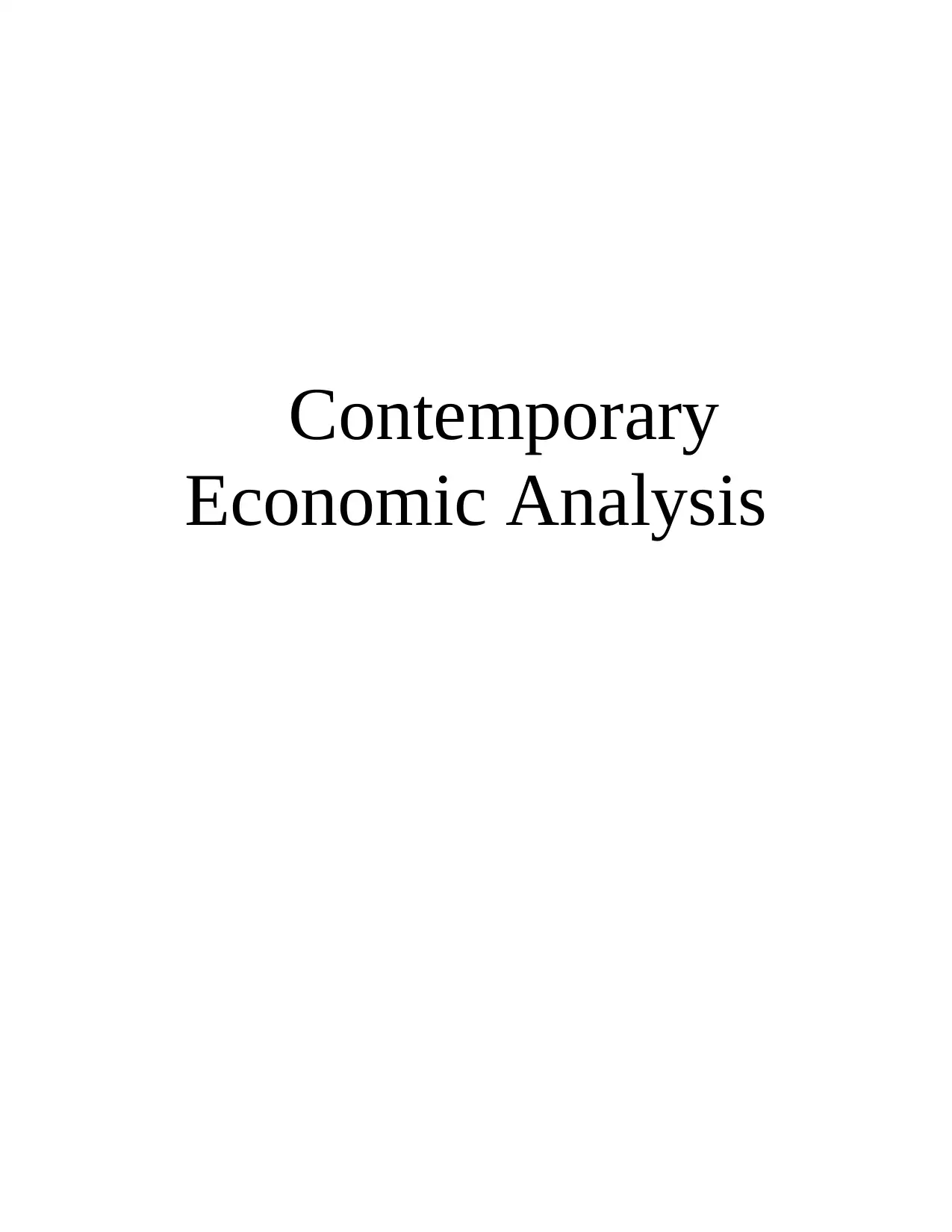
Contemporary
Economic Analysis
Economic Analysis
Secure Best Marks with AI Grader
Need help grading? Try our AI Grader for instant feedback on your assignments.
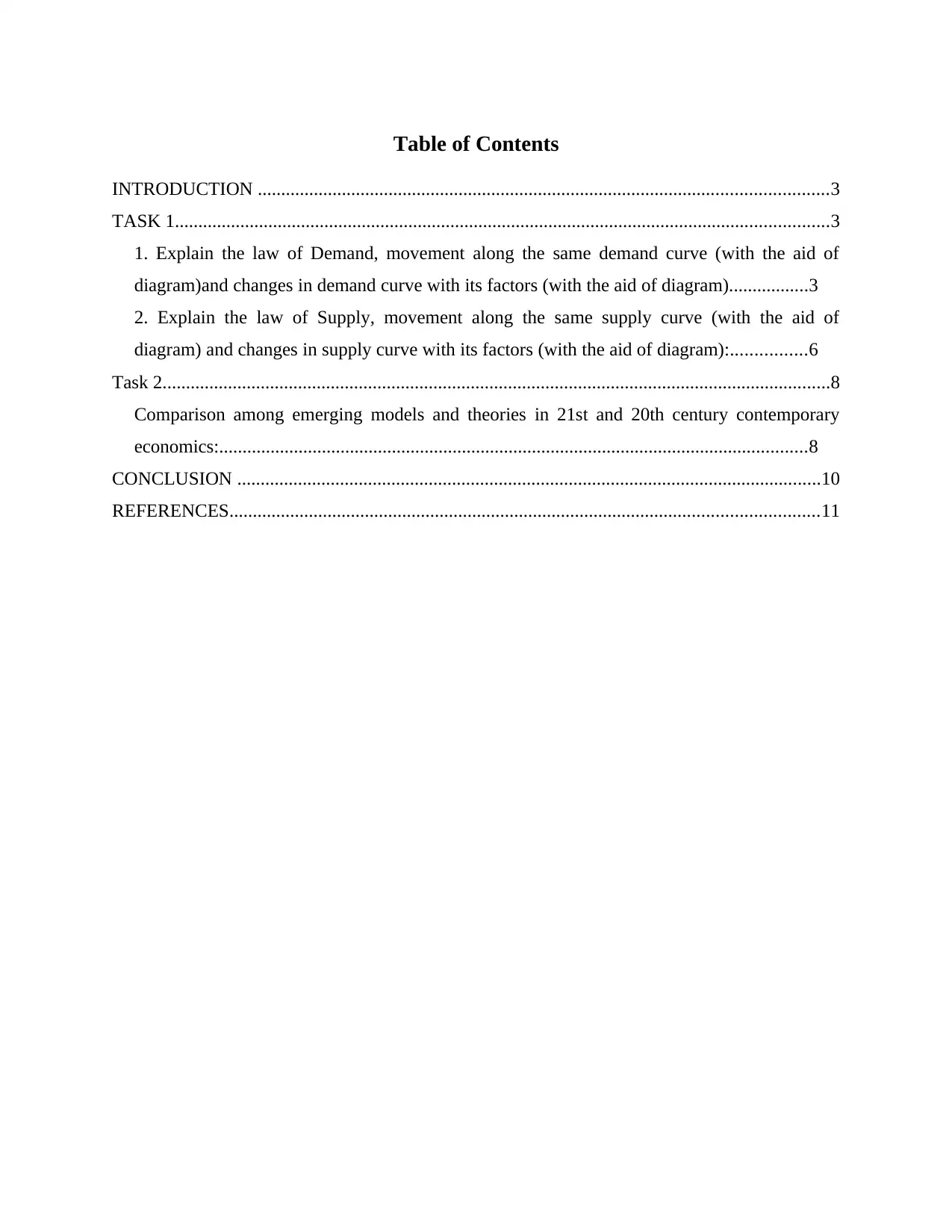
Table of Contents
INTRODUCTION ..........................................................................................................................3
TASK 1............................................................................................................................................3
1. Explain the law of Demand, movement along the same demand curve (with the aid of
diagram)and changes in demand curve with its factors (with the aid of diagram).................3
2. Explain the law of Supply, movement along the same supply curve (with the aid of
diagram) and changes in supply curve with its factors (with the aid of diagram):................6
Task 2...............................................................................................................................................8
Comparison among emerging models and theories in 21st and 20th century contemporary
economics:..............................................................................................................................8
CONCLUSION .............................................................................................................................10
REFERENCES..............................................................................................................................11
INTRODUCTION ..........................................................................................................................3
TASK 1............................................................................................................................................3
1. Explain the law of Demand, movement along the same demand curve (with the aid of
diagram)and changes in demand curve with its factors (with the aid of diagram).................3
2. Explain the law of Supply, movement along the same supply curve (with the aid of
diagram) and changes in supply curve with its factors (with the aid of diagram):................6
Task 2...............................................................................................................................................8
Comparison among emerging models and theories in 21st and 20th century contemporary
economics:..............................................................................................................................8
CONCLUSION .............................................................................................................................10
REFERENCES..............................................................................................................................11
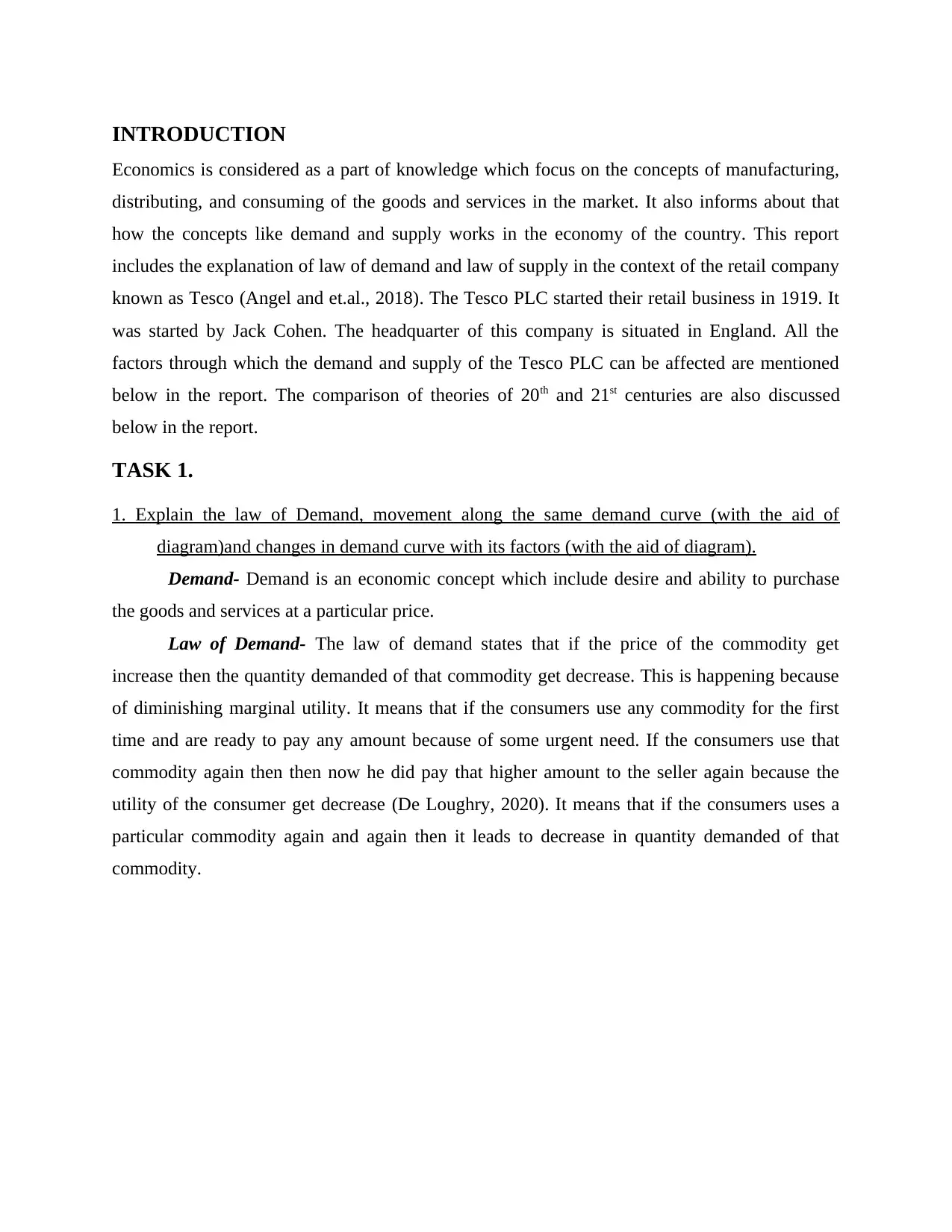
INTRODUCTION
Economics is considered as a part of knowledge which focus on the concepts of manufacturing,
distributing, and consuming of the goods and services in the market. It also informs about that
how the concepts like demand and supply works in the economy of the country. This report
includes the explanation of law of demand and law of supply in the context of the retail company
known as Tesco (Angel and et.al., 2018). The Tesco PLC started their retail business in 1919. It
was started by Jack Cohen. The headquarter of this company is situated in England. All the
factors through which the demand and supply of the Tesco PLC can be affected are mentioned
below in the report. The comparison of theories of 20th and 21st centuries are also discussed
below in the report.
TASK 1.
1. Explain the law of Demand, movement along the same demand curve (with the aid of
diagram)and changes in demand curve with its factors (with the aid of diagram).
Demand- Demand is an economic concept which include desire and ability to purchase
the goods and services at a particular price.
Law of Demand- The law of demand states that if the price of the commodity get
increase then the quantity demanded of that commodity get decrease. This is happening because
of diminishing marginal utility. It means that if the consumers use any commodity for the first
time and are ready to pay any amount because of some urgent need. If the consumers use that
commodity again then then now he did pay that higher amount to the seller again because the
utility of the consumer get decrease (De Loughry, 2020). It means that if the consumers uses a
particular commodity again and again then it leads to decrease in quantity demanded of that
commodity.
Economics is considered as a part of knowledge which focus on the concepts of manufacturing,
distributing, and consuming of the goods and services in the market. It also informs about that
how the concepts like demand and supply works in the economy of the country. This report
includes the explanation of law of demand and law of supply in the context of the retail company
known as Tesco (Angel and et.al., 2018). The Tesco PLC started their retail business in 1919. It
was started by Jack Cohen. The headquarter of this company is situated in England. All the
factors through which the demand and supply of the Tesco PLC can be affected are mentioned
below in the report. The comparison of theories of 20th and 21st centuries are also discussed
below in the report.
TASK 1.
1. Explain the law of Demand, movement along the same demand curve (with the aid of
diagram)and changes in demand curve with its factors (with the aid of diagram).
Demand- Demand is an economic concept which include desire and ability to purchase
the goods and services at a particular price.
Law of Demand- The law of demand states that if the price of the commodity get
increase then the quantity demanded of that commodity get decrease. This is happening because
of diminishing marginal utility. It means that if the consumers use any commodity for the first
time and are ready to pay any amount because of some urgent need. If the consumers use that
commodity again then then now he did pay that higher amount to the seller again because the
utility of the consumer get decrease (De Loughry, 2020). It means that if the consumers uses a
particular commodity again and again then it leads to decrease in quantity demanded of that
commodity.
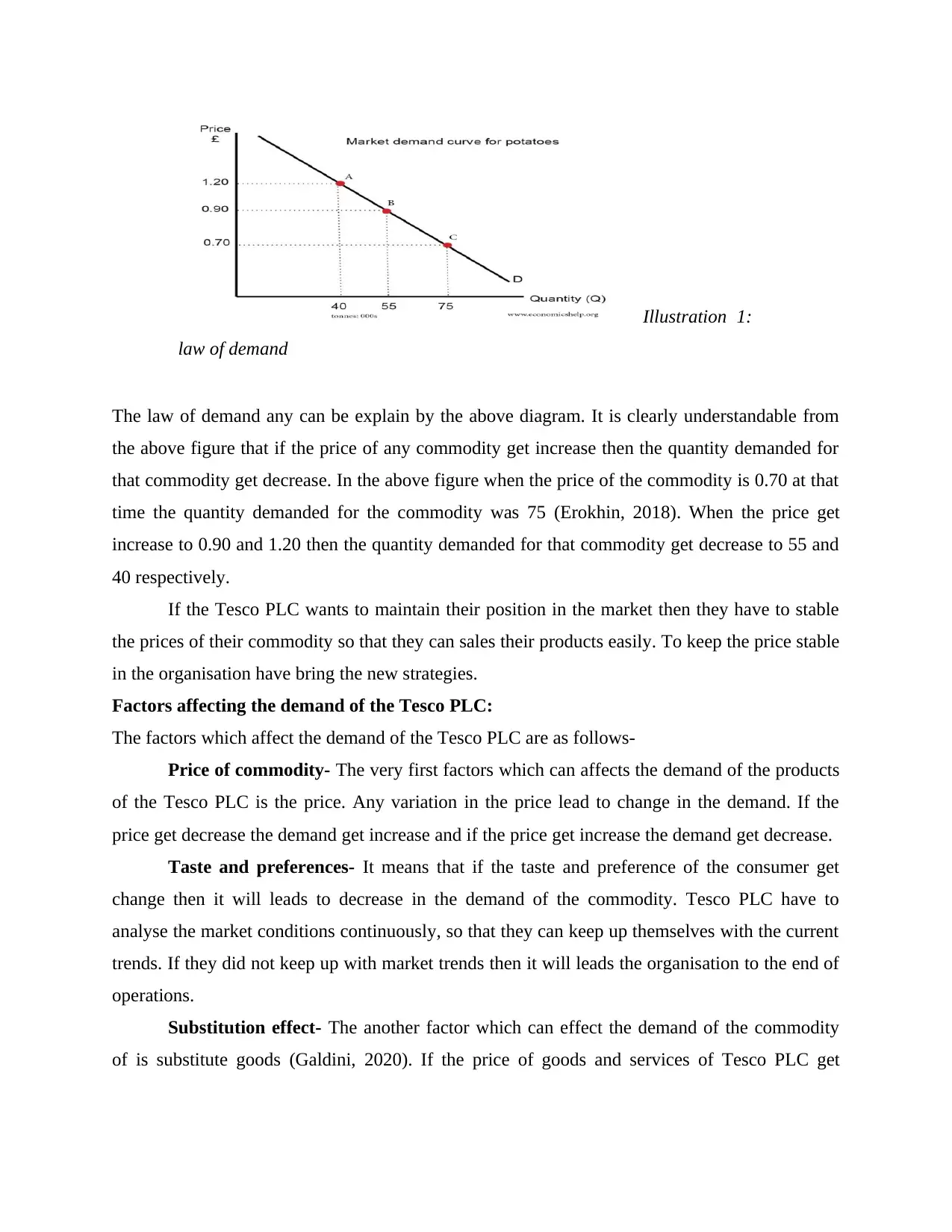
The law of demand any can be explain by the above diagram. It is clearly understandable from
the above figure that if the price of any commodity get increase then the quantity demanded for
that commodity get decrease. In the above figure when the price of the commodity is 0.70 at that
time the quantity demanded for the commodity was 75 (Erokhin, 2018). When the price get
increase to 0.90 and 1.20 then the quantity demanded for that commodity get decrease to 55 and
40 respectively.
If the Tesco PLC wants to maintain their position in the market then they have to stable
the prices of their commodity so that they can sales their products easily. To keep the price stable
in the organisation have bring the new strategies.
Factors affecting the demand of the Tesco PLC:
The factors which affect the demand of the Tesco PLC are as follows-
Price of commodity- The very first factors which can affects the demand of the products
of the Tesco PLC is the price. Any variation in the price lead to change in the demand. If the
price get decrease the demand get increase and if the price get increase the demand get decrease.
Taste and preferences- It means that if the taste and preference of the consumer get
change then it will leads to decrease in the demand of the commodity. Tesco PLC have to
analyse the market conditions continuously, so that they can keep up themselves with the current
trends. If they did not keep up with market trends then it will leads the organisation to the end of
operations.
Substitution effect- The another factor which can effect the demand of the commodity
of is substitute goods (Galdini, 2020). If the price of goods and services of Tesco PLC get
Illustration 1:
law of demand
the above figure that if the price of any commodity get increase then the quantity demanded for
that commodity get decrease. In the above figure when the price of the commodity is 0.70 at that
time the quantity demanded for the commodity was 75 (Erokhin, 2018). When the price get
increase to 0.90 and 1.20 then the quantity demanded for that commodity get decrease to 55 and
40 respectively.
If the Tesco PLC wants to maintain their position in the market then they have to stable
the prices of their commodity so that they can sales their products easily. To keep the price stable
in the organisation have bring the new strategies.
Factors affecting the demand of the Tesco PLC:
The factors which affect the demand of the Tesco PLC are as follows-
Price of commodity- The very first factors which can affects the demand of the products
of the Tesco PLC is the price. Any variation in the price lead to change in the demand. If the
price get decrease the demand get increase and if the price get increase the demand get decrease.
Taste and preferences- It means that if the taste and preference of the consumer get
change then it will leads to decrease in the demand of the commodity. Tesco PLC have to
analyse the market conditions continuously, so that they can keep up themselves with the current
trends. If they did not keep up with market trends then it will leads the organisation to the end of
operations.
Substitution effect- The another factor which can effect the demand of the commodity
of is substitute goods (Galdini, 2020). If the price of goods and services of Tesco PLC get
Illustration 1:
law of demand
Secure Best Marks with AI Grader
Need help grading? Try our AI Grader for instant feedback on your assignments.
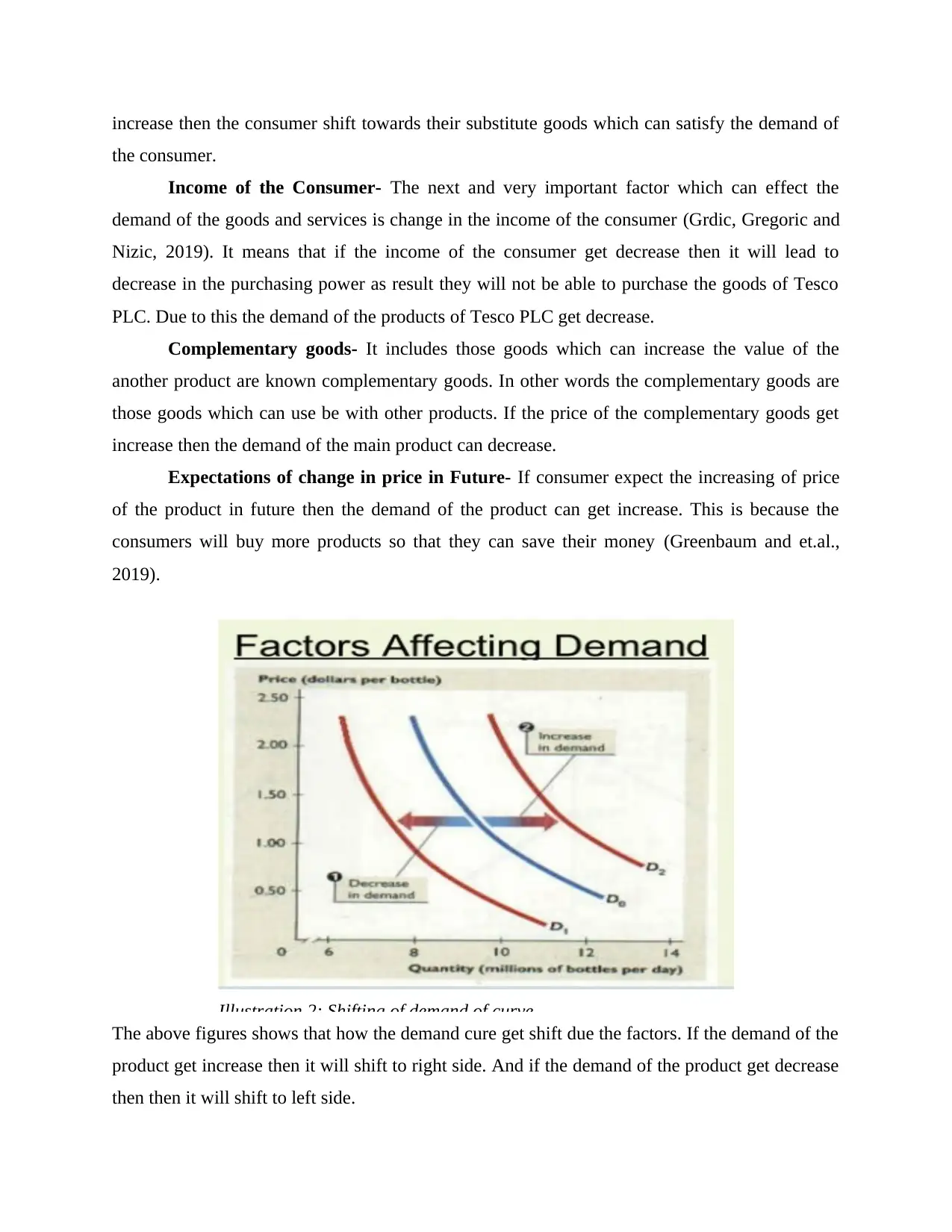
increase then the consumer shift towards their substitute goods which can satisfy the demand of
the consumer.
Income of the Consumer- The next and very important factor which can effect the
demand of the goods and services is change in the income of the consumer (Grdic, Gregoric and
Nizic, 2019). It means that if the income of the consumer get decrease then it will lead to
decrease in the purchasing power as result they will not be able to purchase the goods of Tesco
PLC. Due to this the demand of the products of Tesco PLC get decrease.
Complementary goods- It includes those goods which can increase the value of the
another product are known complementary goods. In other words the complementary goods are
those goods which can use be with other products. If the price of the complementary goods get
increase then the demand of the main product can decrease.
Expectations of change in price in Future- If consumer expect the increasing of price
of the product in future then the demand of the product can get increase. This is because the
consumers will buy more products so that they can save their money (Greenbaum and et.al.,
2019).
The above figures shows that how the demand cure get shift due the factors. If the demand of the
product get increase then it will shift to right side. And if the demand of the product get decrease
then then it will shift to left side.
Illustration 2: Shifting of demand of curve
the consumer.
Income of the Consumer- The next and very important factor which can effect the
demand of the goods and services is change in the income of the consumer (Grdic, Gregoric and
Nizic, 2019). It means that if the income of the consumer get decrease then it will lead to
decrease in the purchasing power as result they will not be able to purchase the goods of Tesco
PLC. Due to this the demand of the products of Tesco PLC get decrease.
Complementary goods- It includes those goods which can increase the value of the
another product are known complementary goods. In other words the complementary goods are
those goods which can use be with other products. If the price of the complementary goods get
increase then the demand of the main product can decrease.
Expectations of change in price in Future- If consumer expect the increasing of price
of the product in future then the demand of the product can get increase. This is because the
consumers will buy more products so that they can save their money (Greenbaum and et.al.,
2019).
The above figures shows that how the demand cure get shift due the factors. If the demand of the
product get increase then it will shift to right side. And if the demand of the product get decrease
then then it will shift to left side.
Illustration 2: Shifting of demand of curve
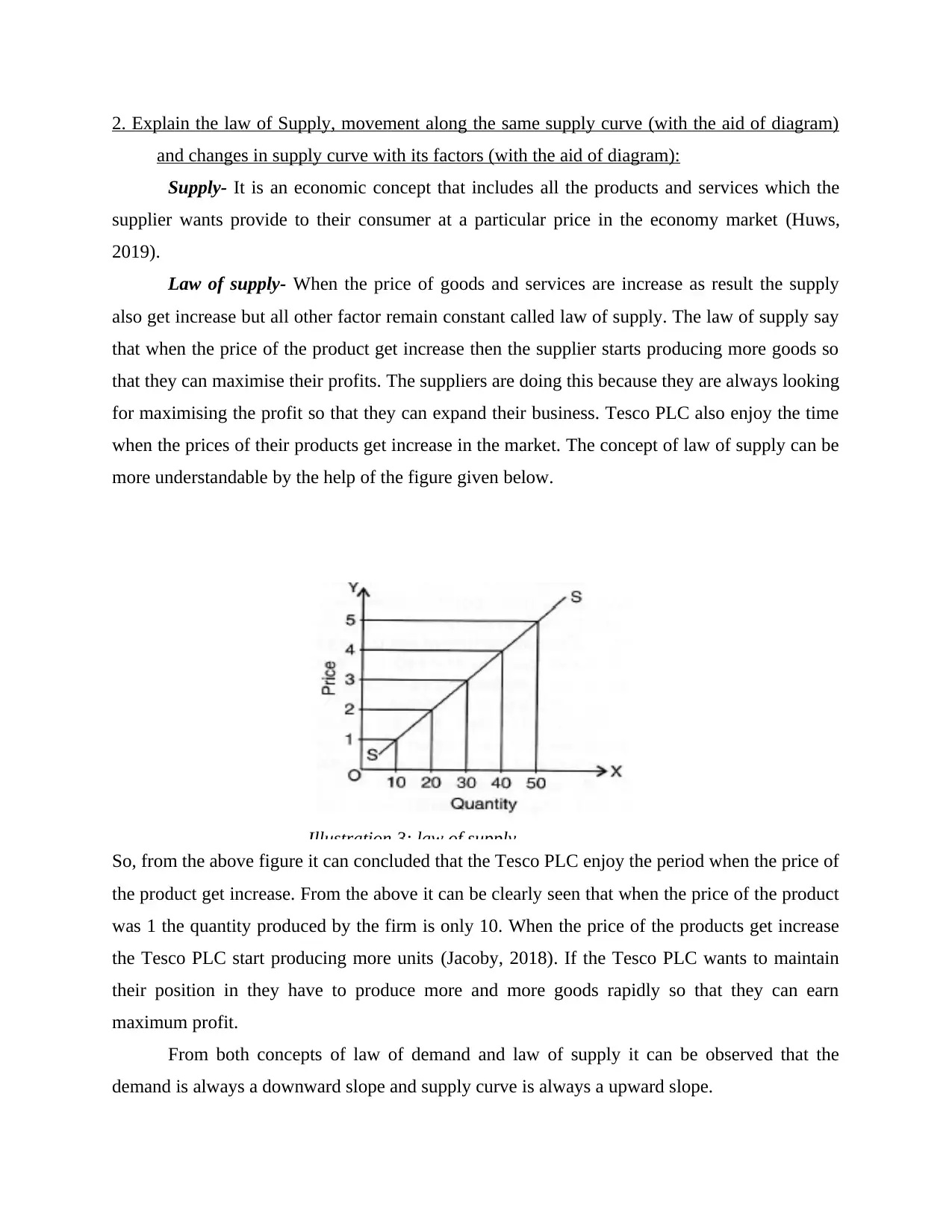
2. Explain the law of Supply, movement along the same supply curve (with the aid of diagram)
and changes in supply curve with its factors (with the aid of diagram):
Supply- It is an economic concept that includes all the products and services which the
supplier wants provide to their consumer at a particular price in the economy market (Huws,
2019).
Law of supply- When the price of goods and services are increase as result the supply
also get increase but all other factor remain constant called law of supply. The law of supply say
that when the price of the product get increase then the supplier starts producing more goods so
that they can maximise their profits. The suppliers are doing this because they are always looking
for maximising the profit so that they can expand their business. Tesco PLC also enjoy the time
when the prices of their products get increase in the market. The concept of law of supply can be
more understandable by the help of the figure given below.
So, from the above figure it can concluded that the Tesco PLC enjoy the period when the price of
the product get increase. From the above it can be clearly seen that when the price of the product
was 1 the quantity produced by the firm is only 10. When the price of the products get increase
the Tesco PLC start producing more units (Jacoby, 2018). If the Tesco PLC wants to maintain
their position in they have to produce more and more goods rapidly so that they can earn
maximum profit.
From both concepts of law of demand and law of supply it can be observed that the
demand is always a downward slope and supply curve is always a upward slope.
Illustration 3: law of supply
and changes in supply curve with its factors (with the aid of diagram):
Supply- It is an economic concept that includes all the products and services which the
supplier wants provide to their consumer at a particular price in the economy market (Huws,
2019).
Law of supply- When the price of goods and services are increase as result the supply
also get increase but all other factor remain constant called law of supply. The law of supply say
that when the price of the product get increase then the supplier starts producing more goods so
that they can maximise their profits. The suppliers are doing this because they are always looking
for maximising the profit so that they can expand their business. Tesco PLC also enjoy the time
when the prices of their products get increase in the market. The concept of law of supply can be
more understandable by the help of the figure given below.
So, from the above figure it can concluded that the Tesco PLC enjoy the period when the price of
the product get increase. From the above it can be clearly seen that when the price of the product
was 1 the quantity produced by the firm is only 10. When the price of the products get increase
the Tesco PLC start producing more units (Jacoby, 2018). If the Tesco PLC wants to maintain
their position in they have to produce more and more goods rapidly so that they can earn
maximum profit.
From both concepts of law of demand and law of supply it can be observed that the
demand is always a downward slope and supply curve is always a upward slope.
Illustration 3: law of supply
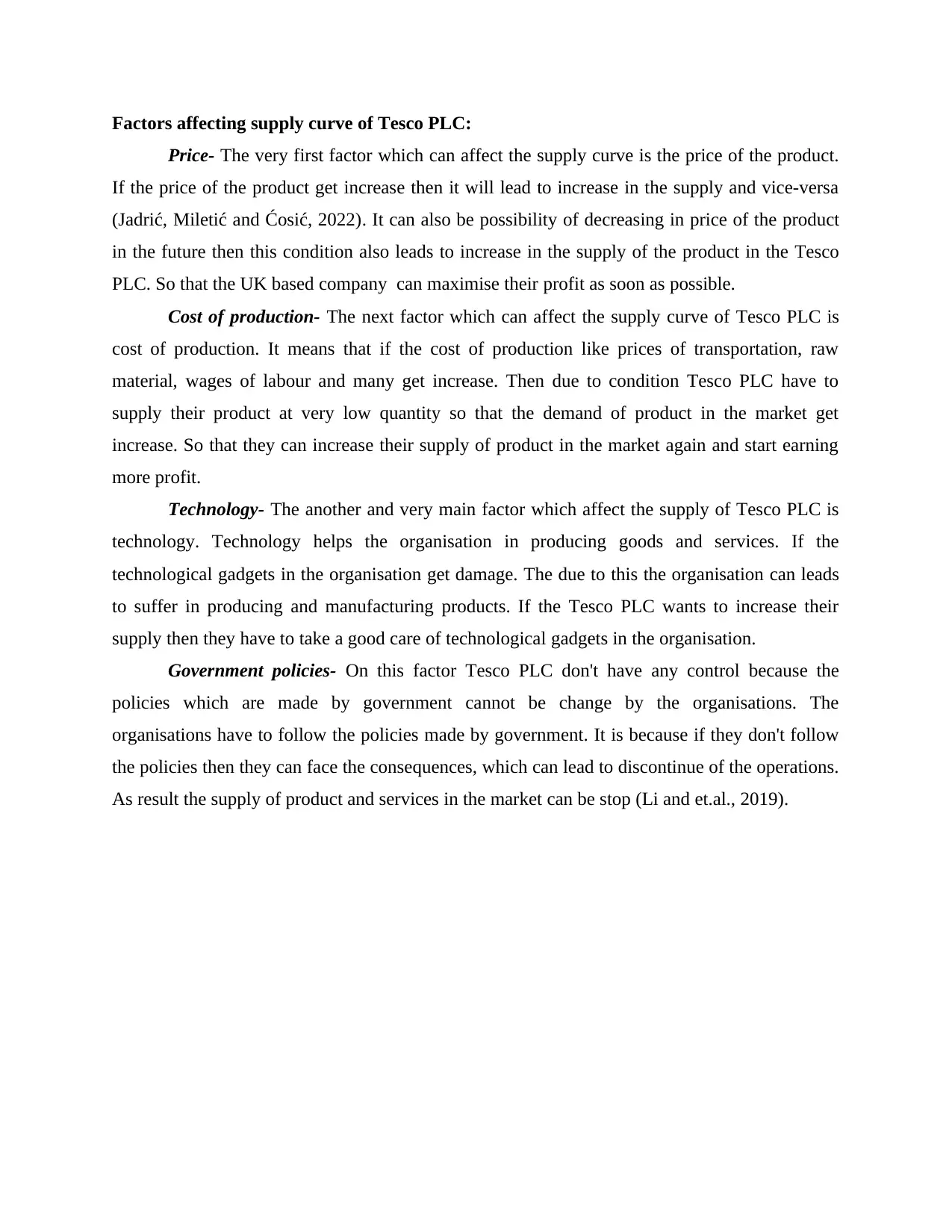
Factors affecting supply curve of Tesco PLC:
Price- The very first factor which can affect the supply curve is the price of the product.
If the price of the product get increase then it will lead to increase in the supply and vice-versa
(Jadrić, Miletić and Ćosić, 2022). It can also be possibility of decreasing in price of the product
in the future then this condition also leads to increase in the supply of the product in the Tesco
PLC. So that the UK based company can maximise their profit as soon as possible.
Cost of production- The next factor which can affect the supply curve of Tesco PLC is
cost of production. It means that if the cost of production like prices of transportation, raw
material, wages of labour and many get increase. Then due to condition Tesco PLC have to
supply their product at very low quantity so that the demand of product in the market get
increase. So that they can increase their supply of product in the market again and start earning
more profit.
Technology- The another and very main factor which affect the supply of Tesco PLC is
technology. Technology helps the organisation in producing goods and services. If the
technological gadgets in the organisation get damage. The due to this the organisation can leads
to suffer in producing and manufacturing products. If the Tesco PLC wants to increase their
supply then they have to take a good care of technological gadgets in the organisation.
Government policies- On this factor Tesco PLC don't have any control because the
policies which are made by government cannot be change by the organisations. The
organisations have to follow the policies made by government. It is because if they don't follow
the policies then they can face the consequences, which can lead to discontinue of the operations.
As result the supply of product and services in the market can be stop (Li and et.al., 2019).
Price- The very first factor which can affect the supply curve is the price of the product.
If the price of the product get increase then it will lead to increase in the supply and vice-versa
(Jadrić, Miletić and Ćosić, 2022). It can also be possibility of decreasing in price of the product
in the future then this condition also leads to increase in the supply of the product in the Tesco
PLC. So that the UK based company can maximise their profit as soon as possible.
Cost of production- The next factor which can affect the supply curve of Tesco PLC is
cost of production. It means that if the cost of production like prices of transportation, raw
material, wages of labour and many get increase. Then due to condition Tesco PLC have to
supply their product at very low quantity so that the demand of product in the market get
increase. So that they can increase their supply of product in the market again and start earning
more profit.
Technology- The another and very main factor which affect the supply of Tesco PLC is
technology. Technology helps the organisation in producing goods and services. If the
technological gadgets in the organisation get damage. The due to this the organisation can leads
to suffer in producing and manufacturing products. If the Tesco PLC wants to increase their
supply then they have to take a good care of technological gadgets in the organisation.
Government policies- On this factor Tesco PLC don't have any control because the
policies which are made by government cannot be change by the organisations. The
organisations have to follow the policies made by government. It is because if they don't follow
the policies then they can face the consequences, which can lead to discontinue of the operations.
As result the supply of product and services in the market can be stop (Li and et.al., 2019).
Paraphrase This Document
Need a fresh take? Get an instant paraphrase of this document with our AI Paraphraser
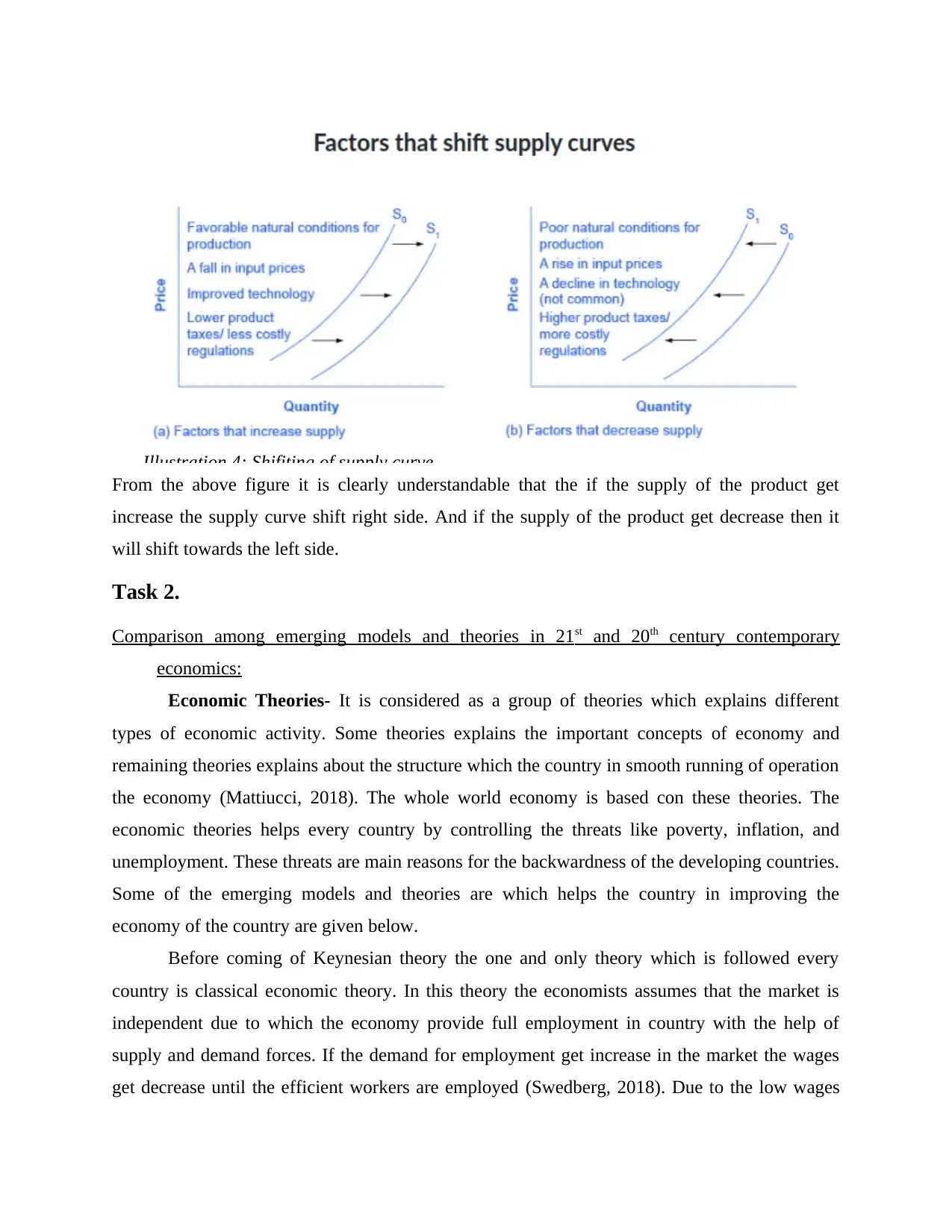
From the above figure it is clearly understandable that the if the supply of the product get
increase the supply curve shift right side. And if the supply of the product get decrease then it
will shift towards the left side.
Task 2.
Comparison among emerging models and theories in 21st and 20th century contemporary
economics:
Economic Theories- It is considered as a group of theories which explains different
types of economic activity. Some theories explains the important concepts of economy and
remaining theories explains about the structure which the country in smooth running of operation
the economy (Mattiucci, 2018). The whole world economy is based con these theories. The
economic theories helps every country by controlling the threats like poverty, inflation, and
unemployment. These threats are main reasons for the backwardness of the developing countries.
Some of the emerging models and theories are which helps the country in improving the
economy of the country are given below.
Before coming of Keynesian theory the one and only theory which is followed every
country is classical economic theory. In this theory the economists assumes that the market is
independent due to which the economy provide full employment in country with the help of
supply and demand forces. If the demand for employment get increase in the market the wages
get decrease until the efficient workers are employed (Swedberg, 2018). Due to the low wages
Illustration 4: Shifiting of supply curve
increase the supply curve shift right side. And if the supply of the product get decrease then it
will shift towards the left side.
Task 2.
Comparison among emerging models and theories in 21st and 20th century contemporary
economics:
Economic Theories- It is considered as a group of theories which explains different
types of economic activity. Some theories explains the important concepts of economy and
remaining theories explains about the structure which the country in smooth running of operation
the economy (Mattiucci, 2018). The whole world economy is based con these theories. The
economic theories helps every country by controlling the threats like poverty, inflation, and
unemployment. These threats are main reasons for the backwardness of the developing countries.
Some of the emerging models and theories are which helps the country in improving the
economy of the country are given below.
Before coming of Keynesian theory the one and only theory which is followed every
country is classical economic theory. In this theory the economists assumes that the market is
independent due to which the economy provide full employment in country with the help of
supply and demand forces. If the demand for employment get increase in the market the wages
get decrease until the efficient workers are employed (Swedberg, 2018). Due to the low wages
Illustration 4: Shifiting of supply curve
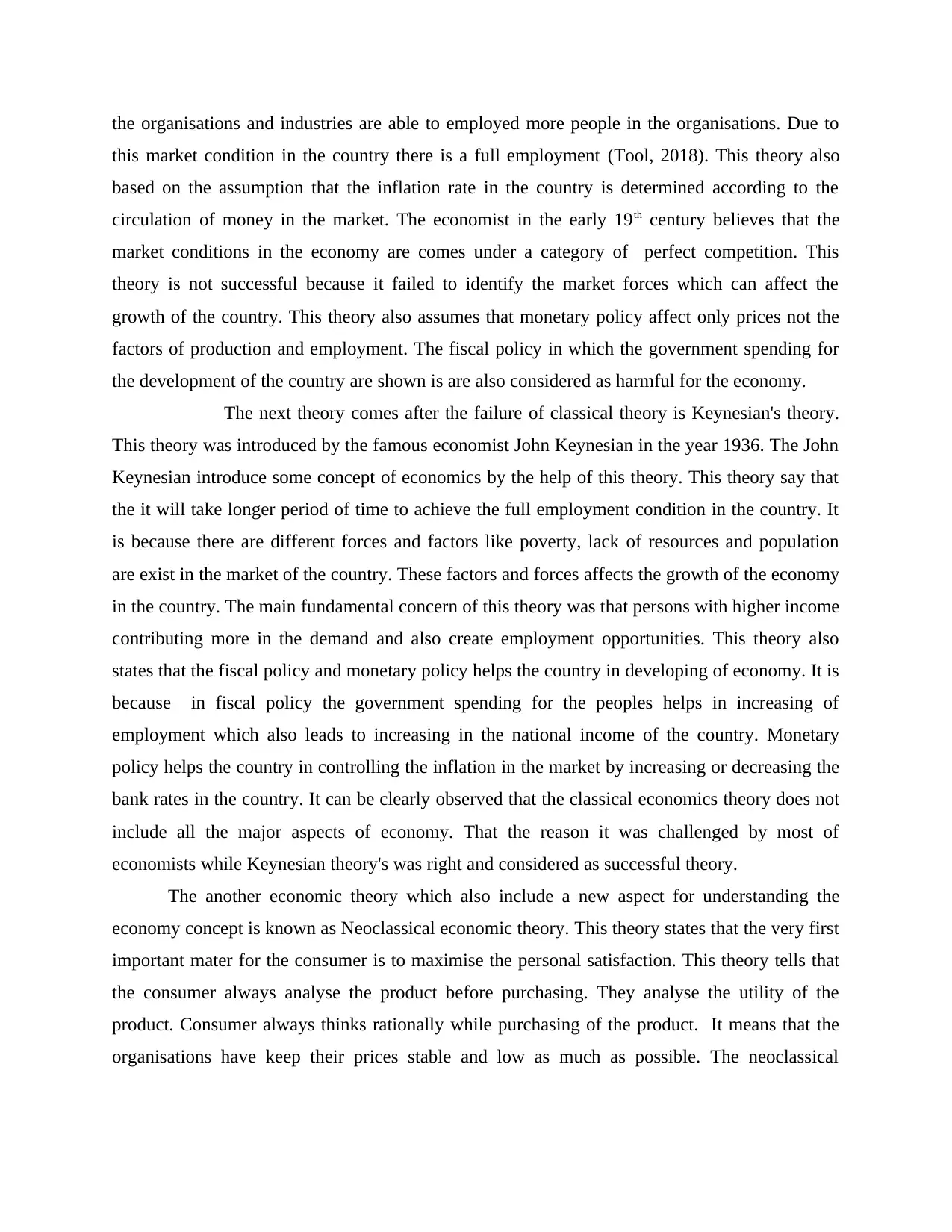
the organisations and industries are able to employed more people in the organisations. Due to
this market condition in the country there is a full employment (Tool, 2018). This theory also
based on the assumption that the inflation rate in the country is determined according to the
circulation of money in the market. The economist in the early 19th century believes that the
market conditions in the economy are comes under a category of perfect competition. This
theory is not successful because it failed to identify the market forces which can affect the
growth of the country. This theory also assumes that monetary policy affect only prices not the
factors of production and employment. The fiscal policy in which the government spending for
the development of the country are shown is are also considered as harmful for the economy.
The next theory comes after the failure of classical theory is Keynesian's theory.
This theory was introduced by the famous economist John Keynesian in the year 1936. The John
Keynesian introduce some concept of economics by the help of this theory. This theory say that
the it will take longer period of time to achieve the full employment condition in the country. It
is because there are different forces and factors like poverty, lack of resources and population
are exist in the market of the country. These factors and forces affects the growth of the economy
in the country. The main fundamental concern of this theory was that persons with higher income
contributing more in the demand and also create employment opportunities. This theory also
states that the fiscal policy and monetary policy helps the country in developing of economy. It is
because in fiscal policy the government spending for the peoples helps in increasing of
employment which also leads to increasing in the national income of the country. Monetary
policy helps the country in controlling the inflation in the market by increasing or decreasing the
bank rates in the country. It can be clearly observed that the classical economics theory does not
include all the major aspects of economy. That the reason it was challenged by most of
economists while Keynesian theory's was right and considered as successful theory.
The another economic theory which also include a new aspect for understanding the
economy concept is known as Neoclassical economic theory. This theory states that the very first
important mater for the consumer is to maximise the personal satisfaction. This theory tells that
the consumer always analyse the product before purchasing. They analyse the utility of the
product. Consumer always thinks rationally while purchasing of the product. It means that the
organisations have keep their prices stable and low as much as possible. The neoclassical
this market condition in the country there is a full employment (Tool, 2018). This theory also
based on the assumption that the inflation rate in the country is determined according to the
circulation of money in the market. The economist in the early 19th century believes that the
market conditions in the economy are comes under a category of perfect competition. This
theory is not successful because it failed to identify the market forces which can affect the
growth of the country. This theory also assumes that monetary policy affect only prices not the
factors of production and employment. The fiscal policy in which the government spending for
the development of the country are shown is are also considered as harmful for the economy.
The next theory comes after the failure of classical theory is Keynesian's theory.
This theory was introduced by the famous economist John Keynesian in the year 1936. The John
Keynesian introduce some concept of economics by the help of this theory. This theory say that
the it will take longer period of time to achieve the full employment condition in the country. It
is because there are different forces and factors like poverty, lack of resources and population
are exist in the market of the country. These factors and forces affects the growth of the economy
in the country. The main fundamental concern of this theory was that persons with higher income
contributing more in the demand and also create employment opportunities. This theory also
states that the fiscal policy and monetary policy helps the country in developing of economy. It is
because in fiscal policy the government spending for the peoples helps in increasing of
employment which also leads to increasing in the national income of the country. Monetary
policy helps the country in controlling the inflation in the market by increasing or decreasing the
bank rates in the country. It can be clearly observed that the classical economics theory does not
include all the major aspects of economy. That the reason it was challenged by most of
economists while Keynesian theory's was right and considered as successful theory.
The another economic theory which also include a new aspect for understanding the
economy concept is known as Neoclassical economic theory. This theory states that the very first
important mater for the consumer is to maximise the personal satisfaction. This theory tells that
the consumer always analyse the product before purchasing. They analyse the utility of the
product. Consumer always thinks rationally while purchasing of the product. It means that the
organisations have keep their prices stable and low as much as possible. The neoclassical
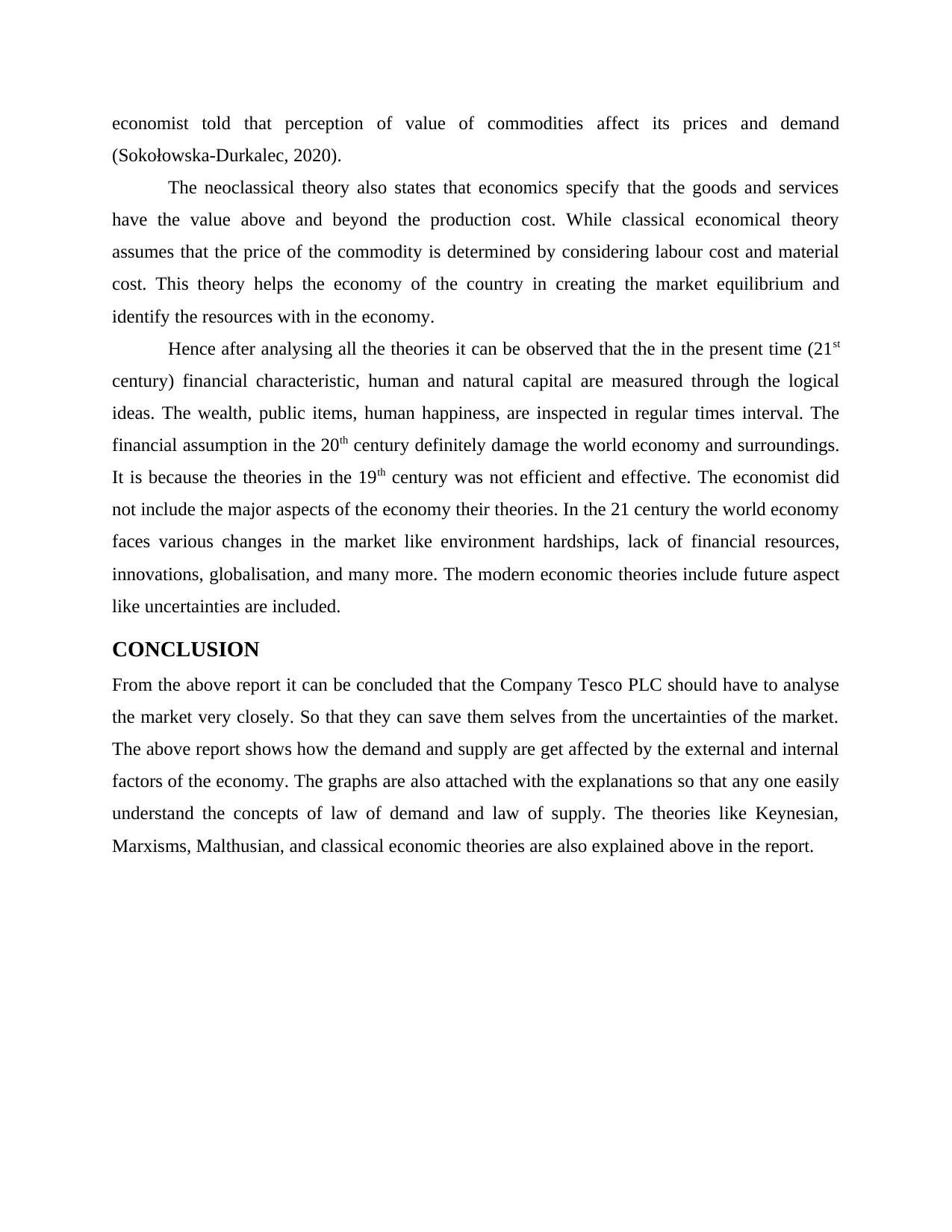
economist told that perception of value of commodities affect its prices and demand
(Sokołowska-Durkalec, 2020).
The neoclassical theory also states that economics specify that the goods and services
have the value above and beyond the production cost. While classical economical theory
assumes that the price of the commodity is determined by considering labour cost and material
cost. This theory helps the economy of the country in creating the market equilibrium and
identify the resources with in the economy.
Hence after analysing all the theories it can be observed that the in the present time (21st
century) financial characteristic, human and natural capital are measured through the logical
ideas. The wealth, public items, human happiness, are inspected in regular times interval. The
financial assumption in the 20th century definitely damage the world economy and surroundings.
It is because the theories in the 19th century was not efficient and effective. The economist did
not include the major aspects of the economy their theories. In the 21 century the world economy
faces various changes in the market like environment hardships, lack of financial resources,
innovations, globalisation, and many more. The modern economic theories include future aspect
like uncertainties are included.
CONCLUSION
From the above report it can be concluded that the Company Tesco PLC should have to analyse
the market very closely. So that they can save them selves from the uncertainties of the market.
The above report shows how the demand and supply are get affected by the external and internal
factors of the economy. The graphs are also attached with the explanations so that any one easily
understand the concepts of law of demand and law of supply. The theories like Keynesian,
Marxisms, Malthusian, and classical economic theories are also explained above in the report.
(Sokołowska-Durkalec, 2020).
The neoclassical theory also states that economics specify that the goods and services
have the value above and beyond the production cost. While classical economical theory
assumes that the price of the commodity is determined by considering labour cost and material
cost. This theory helps the economy of the country in creating the market equilibrium and
identify the resources with in the economy.
Hence after analysing all the theories it can be observed that the in the present time (21st
century) financial characteristic, human and natural capital are measured through the logical
ideas. The wealth, public items, human happiness, are inspected in regular times interval. The
financial assumption in the 20th century definitely damage the world economy and surroundings.
It is because the theories in the 19th century was not efficient and effective. The economist did
not include the major aspects of the economy their theories. In the 21 century the world economy
faces various changes in the market like environment hardships, lack of financial resources,
innovations, globalisation, and many more. The modern economic theories include future aspect
like uncertainties are included.
CONCLUSION
From the above report it can be concluded that the Company Tesco PLC should have to analyse
the market very closely. So that they can save them selves from the uncertainties of the market.
The above report shows how the demand and supply are get affected by the external and internal
factors of the economy. The graphs are also attached with the explanations so that any one easily
understand the concepts of law of demand and law of supply. The theories like Keynesian,
Marxisms, Malthusian, and classical economic theories are also explained above in the report.
Secure Best Marks with AI Grader
Need help grading? Try our AI Grader for instant feedback on your assignments.
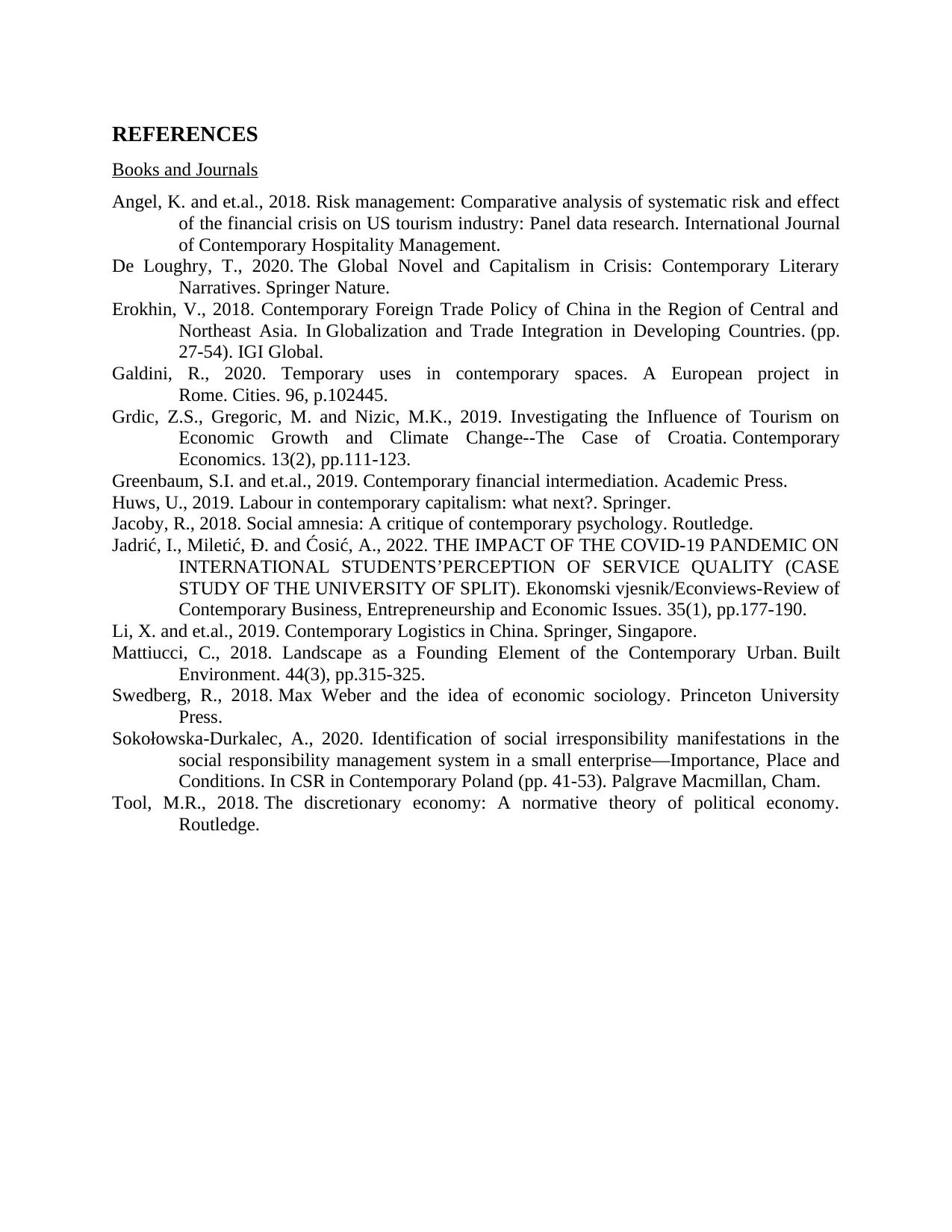
REFERENCES
Books and Journals
Angel, K. and et.al., 2018. Risk management: Comparative analysis of systematic risk and effect
of the financial crisis on US tourism industry: Panel data research. International Journal
of Contemporary Hospitality Management.
De Loughry, T., 2020. The Global Novel and Capitalism in Crisis: Contemporary Literary
Narratives. Springer Nature.
Erokhin, V., 2018. Contemporary Foreign Trade Policy of China in the Region of Central and
Northeast Asia. In Globalization and Trade Integration in Developing Countries. (pp.
27-54). IGI Global.
Galdini, R., 2020. Temporary uses in contemporary spaces. A European project in
Rome. Cities. 96, p.102445.
Grdic, Z.S., Gregoric, M. and Nizic, M.K., 2019. Investigating the Influence of Tourism on
Economic Growth and Climate Change--The Case of Croatia. Contemporary
Economics. 13(2), pp.111-123.
Greenbaum, S.I. and et.al., 2019. Contemporary financial intermediation. Academic Press.
Huws, U., 2019. Labour in contemporary capitalism: what next?. Springer.
Jacoby, R., 2018. Social amnesia: A critique of contemporary psychology. Routledge.
Jadrić, I., Miletić, Đ. and Ćosić, A., 2022. THE IMPACT OF THE COVID-19 PANDEMIC ON
INTERNATIONAL STUDENTS’PERCEPTION OF SERVICE QUALITY (CASE
STUDY OF THE UNIVERSITY OF SPLIT). Ekonomski vjesnik/Econviews-Review of
Contemporary Business, Entrepreneurship and Economic Issues. 35(1), pp.177-190.
Li, X. and et.al., 2019. Contemporary Logistics in China. Springer, Singapore.
Mattiucci, C., 2018. Landscape as a Founding Element of the Contemporary Urban. Built
Environment. 44(3), pp.315-325.
Swedberg, R., 2018. Max Weber and the idea of economic sociology. Princeton University
Press.
Sokołowska-Durkalec, A., 2020. Identification of social irresponsibility manifestations in the
social responsibility management system in a small enterprise—Importance, Place and
Conditions. In CSR in Contemporary Poland (pp. 41-53). Palgrave Macmillan, Cham.
Tool, M.R., 2018. The discretionary economy: A normative theory of political economy.
Routledge.
Books and Journals
Angel, K. and et.al., 2018. Risk management: Comparative analysis of systematic risk and effect
of the financial crisis on US tourism industry: Panel data research. International Journal
of Contemporary Hospitality Management.
De Loughry, T., 2020. The Global Novel and Capitalism in Crisis: Contemporary Literary
Narratives. Springer Nature.
Erokhin, V., 2018. Contemporary Foreign Trade Policy of China in the Region of Central and
Northeast Asia. In Globalization and Trade Integration in Developing Countries. (pp.
27-54). IGI Global.
Galdini, R., 2020. Temporary uses in contemporary spaces. A European project in
Rome. Cities. 96, p.102445.
Grdic, Z.S., Gregoric, M. and Nizic, M.K., 2019. Investigating the Influence of Tourism on
Economic Growth and Climate Change--The Case of Croatia. Contemporary
Economics. 13(2), pp.111-123.
Greenbaum, S.I. and et.al., 2019. Contemporary financial intermediation. Academic Press.
Huws, U., 2019. Labour in contemporary capitalism: what next?. Springer.
Jacoby, R., 2018. Social amnesia: A critique of contemporary psychology. Routledge.
Jadrić, I., Miletić, Đ. and Ćosić, A., 2022. THE IMPACT OF THE COVID-19 PANDEMIC ON
INTERNATIONAL STUDENTS’PERCEPTION OF SERVICE QUALITY (CASE
STUDY OF THE UNIVERSITY OF SPLIT). Ekonomski vjesnik/Econviews-Review of
Contemporary Business, Entrepreneurship and Economic Issues. 35(1), pp.177-190.
Li, X. and et.al., 2019. Contemporary Logistics in China. Springer, Singapore.
Mattiucci, C., 2018. Landscape as a Founding Element of the Contemporary Urban. Built
Environment. 44(3), pp.315-325.
Swedberg, R., 2018. Max Weber and the idea of economic sociology. Princeton University
Press.
Sokołowska-Durkalec, A., 2020. Identification of social irresponsibility manifestations in the
social responsibility management system in a small enterprise—Importance, Place and
Conditions. In CSR in Contemporary Poland (pp. 41-53). Palgrave Macmillan, Cham.
Tool, M.R., 2018. The discretionary economy: A normative theory of political economy.
Routledge.
1 out of 11
Related Documents
Your All-in-One AI-Powered Toolkit for Academic Success.
+13062052269
info@desklib.com
Available 24*7 on WhatsApp / Email
![[object Object]](/_next/static/media/star-bottom.7253800d.svg)
Unlock your academic potential
© 2024 | Zucol Services PVT LTD | All rights reserved.


